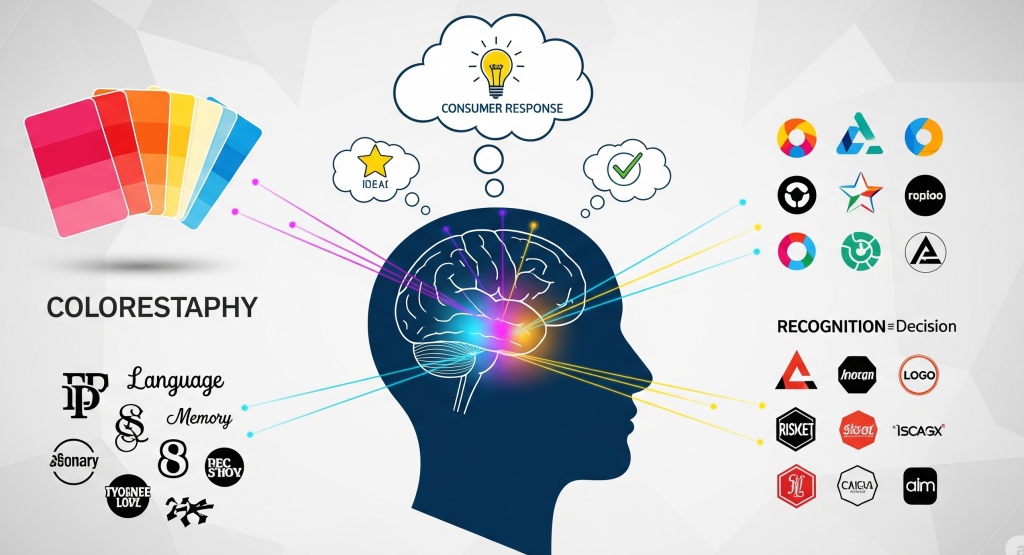Introduction
People frequently believe they are making logical decisions when they buy anything based on factors like price, features, or reviews. However, in reality, a significant amount of decision-making occurs in the subconscious. Among the most powerful influences? Graphic design. Every visual component, from the colors we see to the typefaces we read, influences our perception of a brand and whether or not we act on it. For this reason, marketers frequently claim that “design sells.”
This blog will discuss how graphic design affects consumer choices at all points of contact, from digital advertisements to packaging, and why companies cannot afford to ignore it.
The Psychology Behind Visual Choices
Humans are capable of processing visual information 60,000 times more quickly than textual information. This indicates that design conveys meaning instantaneously before a consumer even contemplates the specifics.
Psychology significantly influences this phenomenon:
- Shapes: Rounded shapes evoke feelings of friendliness and safety, whereas sharp angles impart a sense of power or authority.
- White space: A cluttered design can overwhelm the cognitive process, while a clean layout instills a sense of trustworthiness.
- First impressions: According to research, consumers can create an opinion about a brand’s design in as little as 50 milliseconds.
Consequently, this is why intentional design is not merely aesthetically pleasing it is also persuasive.

Color, Fonts, and the Emotions They Spark
Colors and typography aren’t chosen at random they’re carefully selected to trigger emotional responses.
- Colors:
- Red → urgency, passion, appetite (often used in fast food).
- Blue → trust, security (popular among banks and tech).
- Green → health, growth, sustainability.
- Red → urgency, passion, appetite (often used in fast food).
- Fonts:
- Serif typefaces, such as Times New Roman, are dependable and traditional.
- Sans-serif fonts (like Helvetica) → modern, clean, accessible.
- Script fonts → creativity, elegance.
When combined effectively, these choices directly impact how graphic design influences consumer decisions in subtle but powerful ways.
How Layout and Simplicity Drive Action
Consider the apps or websites you use on a daily basis. The most well-known ones Amazon, Apple, and Airbnb are made to be clear and simple.Layout determines whether a user stays or leaves in a matter of seconds.
- The eye is naturally guided by a clear hierarchy (headlines > subheads > text).
- Decisions are made easier when there is less clutter since it lessens cognitive burden.
- Conversions are driven by call-to-action positions, buttons, and icons.
Being simple implies being intuitive, not dull. Customers are more likely to finish a transaction if the process is simple.
Brand Consistency and Trust-Building
In the digital world of today, trust equals money. Customers get confused by inconsistent branding like mismatched logos, clashing colors, or packaging which can happen when using Canva without a clear brand guide.
- Design consistency increases credibility and recognition. Coca-Cola, for instance, has been using the same red and white color scheme for many years.
- Nike uses the swoosh and a straightforward design to highlight athletic focus.
- Consistency eventually teaches the brain, “This brand is dependable.” Additionally, consumers purchase more from brands they trust.
Packaging Design: The Silent Salesperson
When comparing two similar products, the design frequently serves as the pivotal element influencing consumer preferences.Sophisticated minimalist packaging suggests high quality, whereas vibrant and playful designs quickly attract the attention of children and families.
Packaging that is eco-friendly, utilizing natural hues or recyclable materials, resonates strongly with buyers who prioritize sustainability and responsible consumption.The potency of this influence is heightened by the fact that often, consumers are not consciously aware that design is shaping their perceptions and purchasing choices.
Subtle visual elements, including colors, typography, and layouts, collaborate to form an impression that can sway the decision in favor of one product over another, establishing graphic design as a significant factor at the point of sale.
Digital Design and the Online Buying Journey
With more shopping happening online, digital design has become a key sales driver. Here’s how design impacts each stage:
- Social media ads: Eye-catching visuals stop the scroll.
- Websites: Clean design builds trust; poor design drives abandonment.
- E-commerce pages: High-quality product images increase conversions by up to 30%.
From Instagram posts to checkout pages, digital design guides the consumer journey seamlessly. Without it, even the best products struggle to sell.
Case Examples: When Design Changed the Game
- Apple: Minimalist design isn’t just in their products but also in their marketing. Sleek, white, simple layouts reinforce innovation and quality.
- McDonald’s: The golden arches and red-yellow color scheme are instantly recognizable worldwide, sparking appetite and familiarity.
- Airbnb: A design overhaul in 2014 helped transform it from a niche startup into a global brand by creating a friendlier, more accessible look.
These examples prove that design isn’t just decoration it’s a strategic business tool.
Conclusion
At every stage of the purchasing process whether it involves examining items on a shelf, browsing through Instagram, or unboxing a product design conveys significance. It fosters trust, evokes emotions, and drives actions.
In the end, graphic design affects consumer choices more than many individuals recognize. Companies that prioritize robust, consistent, and psychology-informed design do not merely sell products they cultivate enduring relationships with their customers.
If design can influence perception in mere seconds, then investing in it is not merely a choiceit is a necessity. This is where Wiraa plays a crucial role. As a global remote job platform, Wiraa links skilled designers with opportunities worldwide, enabling businesses to tap into the right expertise while allowing professionals the freedom to work from any location.




